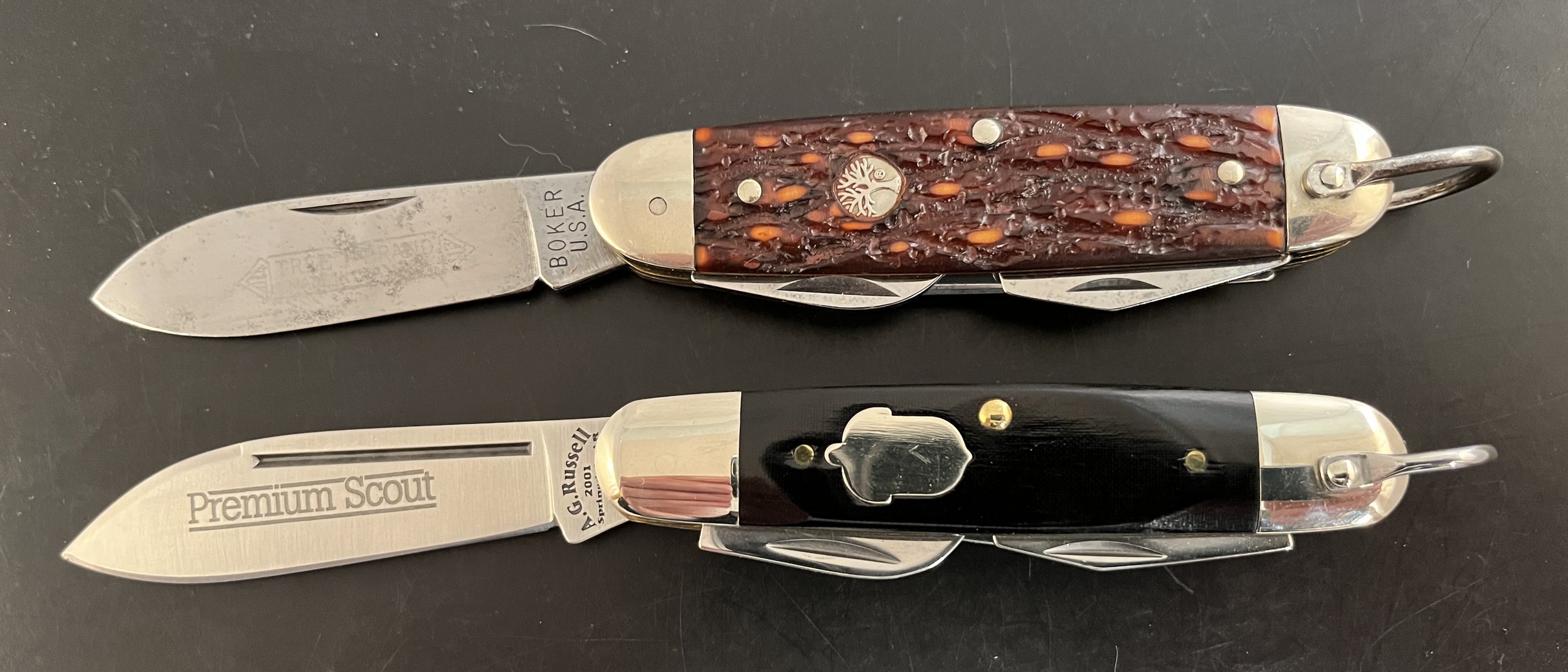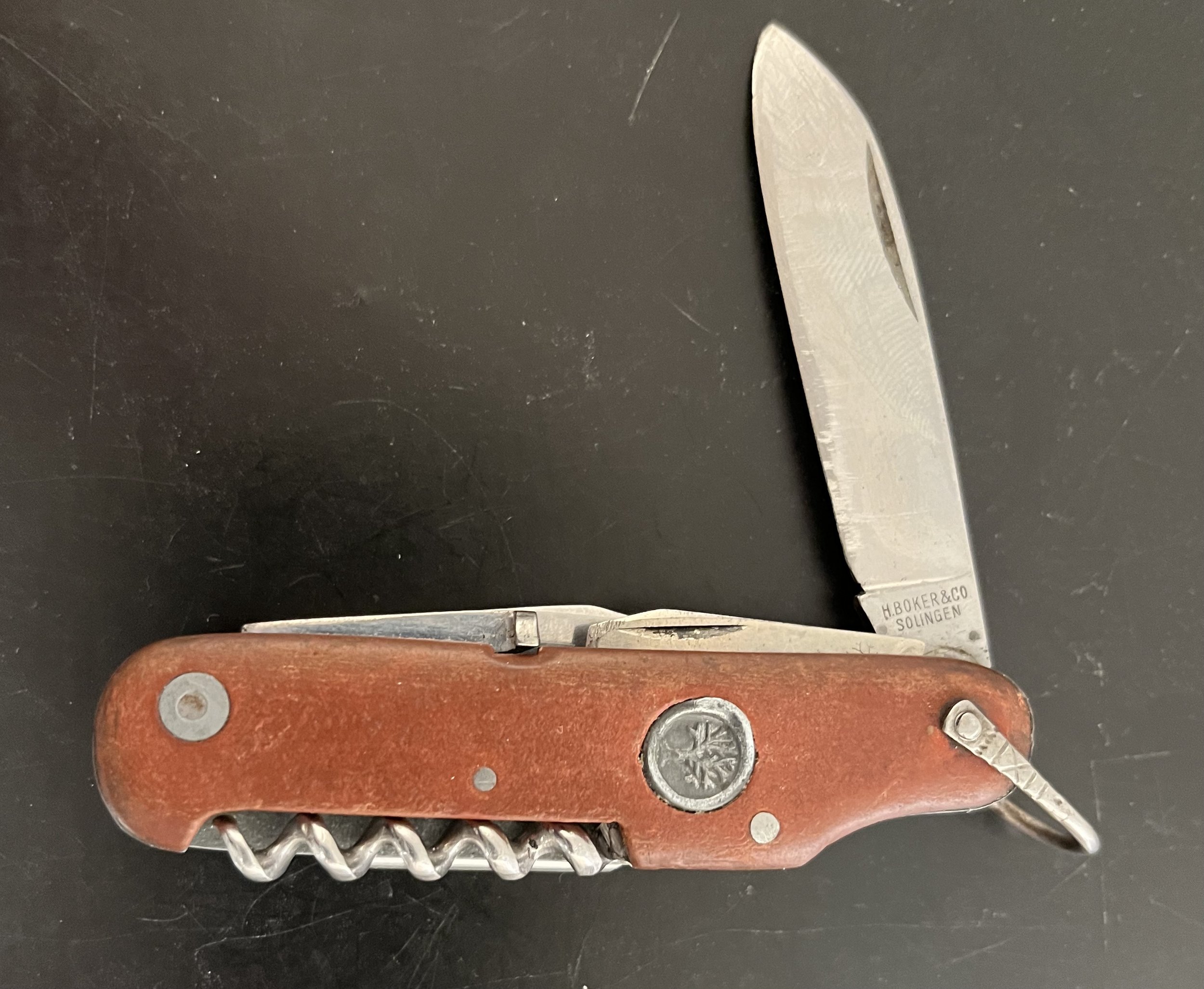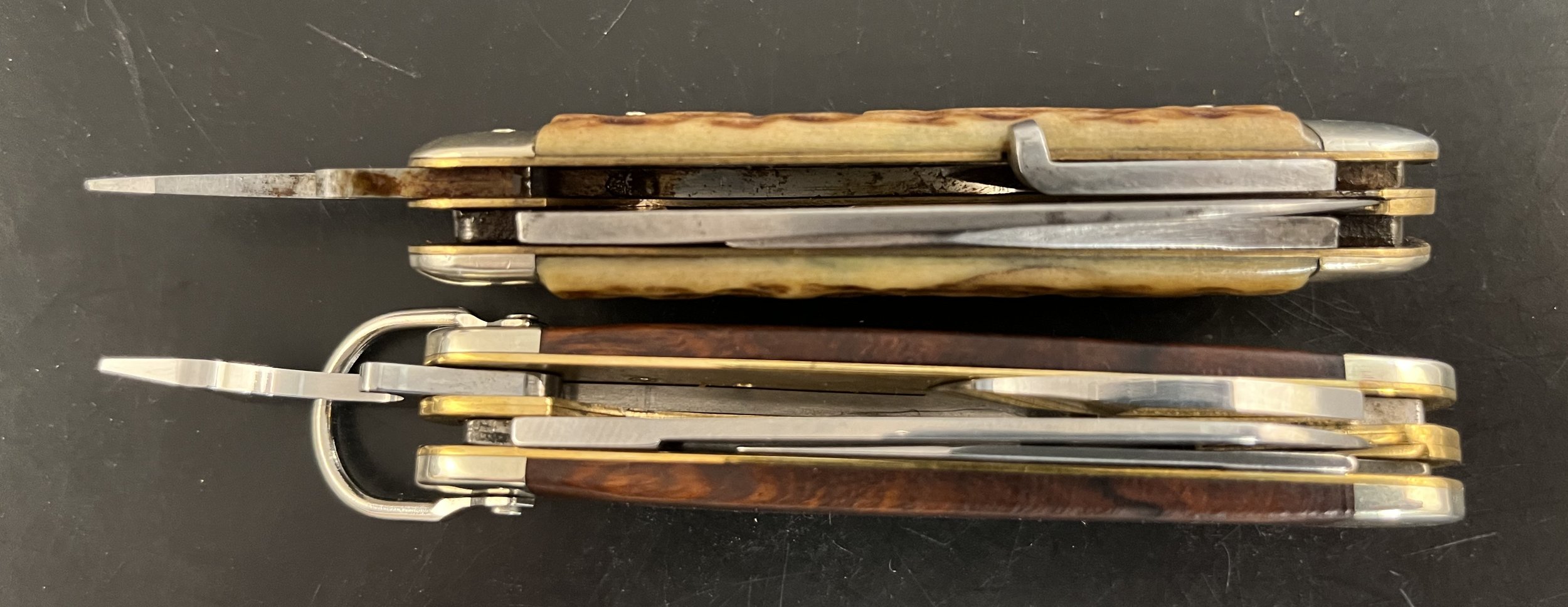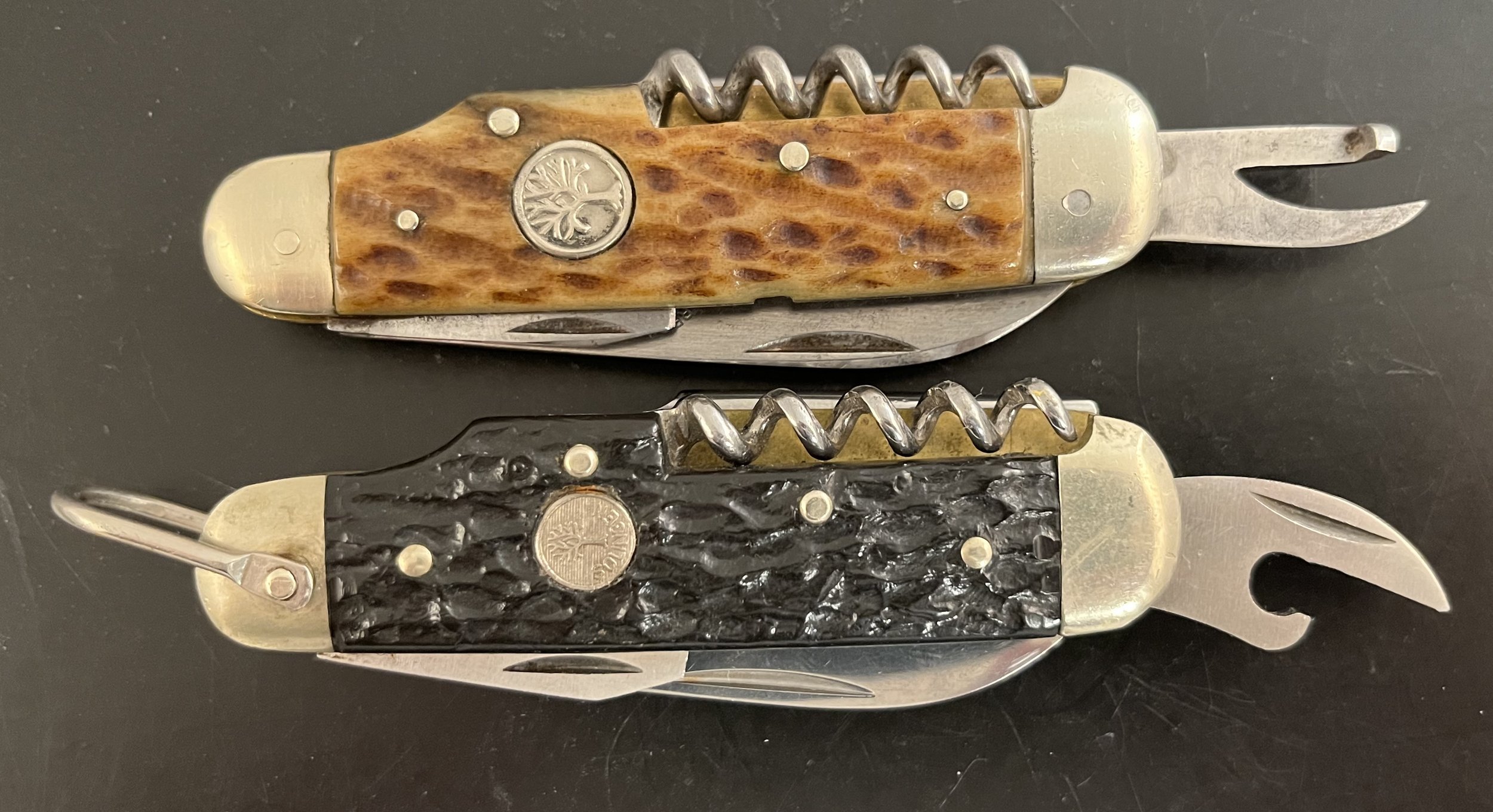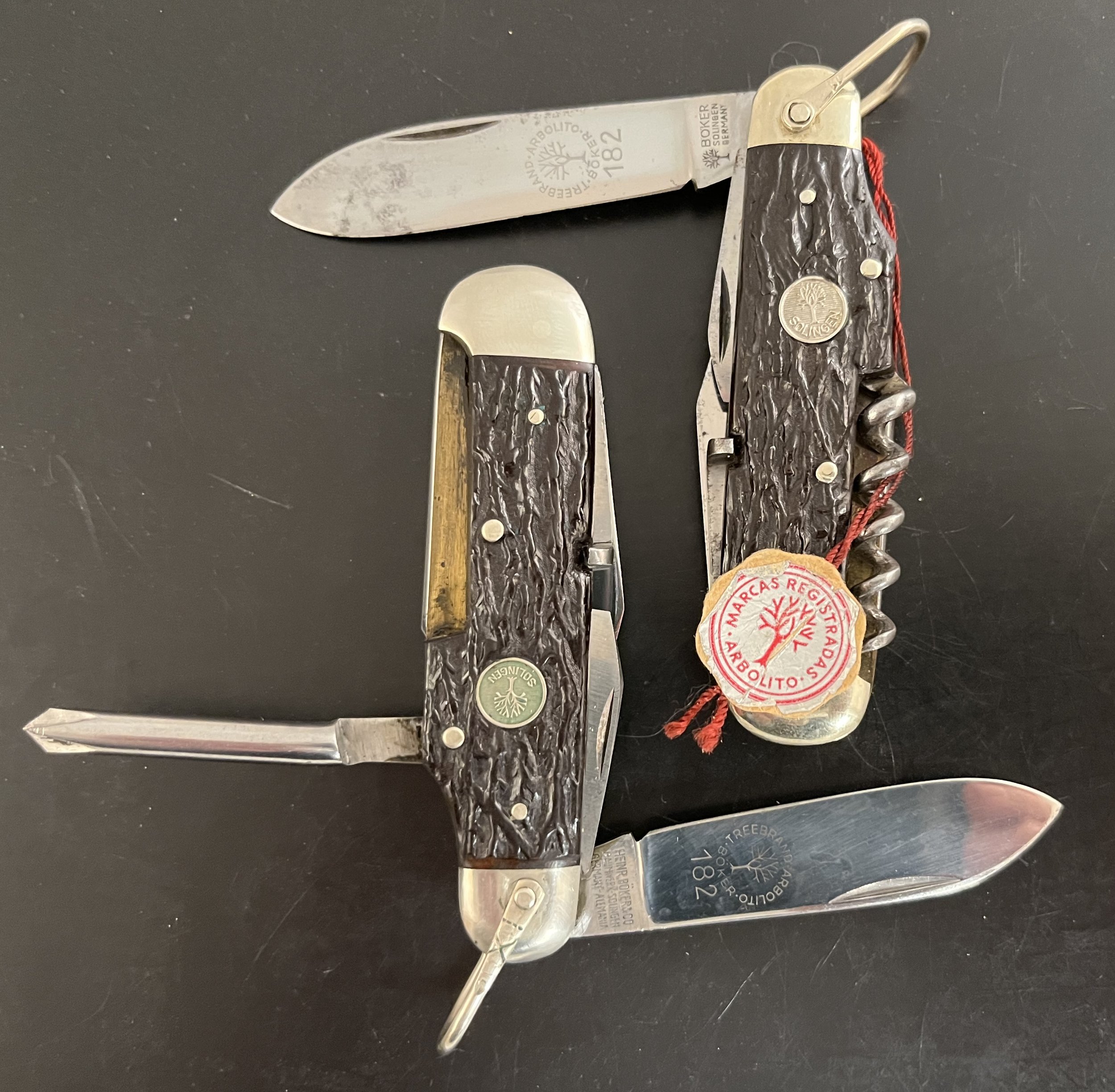Song of the Humpback: Collecting the Böker 182 and Other Humpback 6-Bladed Scout/Camp Knives
Myron Erickson
The knives of boyhood.
I discovered Swiss Army Knives and Victorinox as a 13-year-old with lawn mowing money burning a hole in his pocket. After that first 84 mm Tinker, the hook was set. But even before that first Tinker, I owned and lost a few inexpensive American-made 4-blade scout/camp knives as a younger boy. I always wondered why the handles, which I now know were Delrin, had that funny texture and looked the way they did. I didn’t understand they were emulating jigged bone, itself a natural material used as a cheaper alternative to genuine antler, the über-traditional knifemaking handle material more commonly referred to as stag. A synthetic facsimile of a natural facsimile of the real thing.
The Delrin scout knives of youth. L to R: Ulster, Western, Ka-Bar, and Craftsman.
As my years as an avid SAK collector have passed, I’ve incidentally picked up a few of these old scout-pattern knives, the ones that remind me of boyhood, but I never had any overarching collecting goal. I just followed my nose and when I saw a knife I liked, I bought it. A few arrived as the also-won prizes in auction lots that contained the SAK I was actually after. I’ve given away a dozen or so of these American scout/camp knives to neighbor kids, family and friends, anyone who seemed like they would appreciate a decent, if not extraordinary, pocket knife.
Modern scout-pattern classics. Top to bottom: Boker USA 9361 from the 1980’s, A.G. Russell Premium Scout from 2001.
And then a few years ago, a non-SAK-related thread over on multitool.org got me paying more attention to traditional 4-blade American-made scout/camp knives, which ended up tickling a latent collecting interest. And thus, once again my aimless accumulator ways (d)evolved into the full-on madness of a focused collector. What I love about these humble knives is how they hearken back to my grandfathers’ era and evoke the early 20th century in America with the names of mostly long-gone knifemaking companies. These knives place me in the stories and settings I was reading about as a boy, like Sterling North’s Rascal, and, later, Hemingway’s Nick Adams character.
No Delrin here: classic 4-blade scout/camp knives.. Top to bottom: Camillus 3-line (1940’s), John Primble 3335 (1950’s), and Boker USA 9361 (1960’s).
The Böker 182.
My interest in these American-made, jigged-bone-shod, carbon steel pocket tools from yesteryear resulted in a small collection of 4-blade scout/camp knives from great names like Camillus, Remington, Ulster, Western, A.G. Russell, and Boker USA. Among my American-made Bokers are three different generations of the Model 9361, which, in turn, led me to the German Böker 6-implement scout/camp knife, their famous humpback Model 182. (Take note of the spelling difference between the two companies: Boker/Böker).
Two modern Böker 182’s with smooth horn scales (top) and oak scales (bottom). Note the different blade etches.
In addition to the Model 182, nearly identical humpbacks were also produced by a variety of makers in Germany and America, some of which are still around though their humpback pattern knife is long gone. There was no denying it; the more I learned of the humpback’s story, the more redolent of my Confusing Fall Warbler rabbit hole it became. And speaking of things to take note of, it turns out that if you speed up the song of a humpbacked whale it sounds just like birdsong. Humpbacks, warblers. Coincidence? I like to think not.
Humpback History.
The humpback’s design dates to the late-1920’s and is virtually unchanged today, but determining which company was first to the market finish line with the humpback is a matter of conjecture. Remington started using its two-piece can opener on its scout and utility knives in 1924 (receiving a patent for it in 1927), and I’ve seen Remington advertisements dated 1928 featuring their humpback, the Model R3843. If Remington was the first company to produce and sell the humpback in the U.S., I also think it’s possible, maybe even likely, that Remington got the idea from the Solingen-trained cutlers it poached from Boker (USA) to jump start its cutlery business after World War I. The man who invented that two-piece can opener, Carl Tillmanns, had been working at Boker (USA) when Remington hired him. Most of Remington’s standard pocket knife patterns were openly copied from Boker (USA) patterns, so it hardly seems a stretch to think that Böker Germany’s Model 182 was among those poached designs, even if the 182 had yet to appear on the market in the U.S. (which I don’t believe it did until the 1950’s-’60’s).
Top, Remington’s two-piece can opener. Bottom, Böker’s contemporaneous one-piece tool.
Böker says it’s been making a 6-blade scout/utility knife since 1869, but prior to 1930 when the Model 182 appeared, their 6-blade knife wasn’t of a humpback design. Rather, it was the symmetrical shape of the Victorinox “Officer’s and Sports Knife,” which today we call the Spartan, and which originally appeared in 1897. Which kinda makes you wonder where Victorinox got the idea. As I’ve said before, Karl Elsener’s genius was as an industrialist and organizer; I think of him as the Henry Ford of pocket knives.
Left to right: Böker 182, Remington R3843, Hartkopf & Co., and Böker Freilauf Torpedo.
So, the Remington R3843 appeared sometime between 1924 and 1928, at the latest, and the Böker 182 followed shortly thereafter in 1930. And the success of the basic design appears to have caught on, because there followed a mid-20th-century profusion of similarly patterned humpback scout/camp knives produced, mostly, by other Solingen makers. There were also a couple American makers producing a humpback, but the classic 4-blade scout/camp knife seems to have reigned supreme in the pockets of 20th century American consumers (not to mention soldiers).
Your mission, should you accept it.
Tracking down a good Remington R3843 or a Böker 182 from any era is a fairly easy matter requiring only a little time (and a slightly more robust budget). Remington stopped making their own knives in 1940 but good original examples are not all that rare today. And given the Model 182’s long run of 92 years and counting, you could spend the rest of your life collecting interesting Böker 182’s and never have two alike. Finding some of the other humpbacks is where it gets challenging, and could be a dream opportunity for the research-oriented, rabbit-hole-following collector. It might also constitute what my long-suffering spouse will use someday as evidence in her suit to wrest legal control of my personal finances away from me and have me committed.
Left to right: Friedrich Herder, Jowika, Hartkopf & Co., Freilauf Torpedo Böker for Fichtel Sachs A.G..
In addition to Remington and Böker, I’ve identified seventeen other companies that produced (or marked and sold as their own) the 6-bladed humpback scout/camp knife from the pre-WWII era right through the 2000’s. They range from original knives made as pocket tools for consumers to tribute pieces and re-issues made for collectors. There are likely others that I haven’t discovered yet, which keeps it fun and interesting. If you think you have room in your collection for just one, or you’re looking for a good daily carrier and want to try the humpback pattern, I’d recommend you buy a brand new Böker Camp Knife Classic Gold. They are beautiful to behold and incorporate the latest features tool- and construction-wise. They are available right from Böker, but are also widely discounted at knife retailers around the world.
The Böker Camp Knife Classic Gold. I like this knife so much I bought one to use and one to squirrel away. Image compliments bokerUSA.com.
But if you decide to pursue vintage humpbacks, whether from Böker or other makers, a few things to keep an eye out for include scale material, tool steel used, construction and design, can opener style, bail location and decoration, and overall use and abuse. An experienced collector of any kind of pocket knife won’t be a stranger to any of these things, but a few words might help the less experienced. Perhaps the most immediately noticeable feature of any pocket knife is the material, texture, and color of its scales, so let’s start there.
A modern Weidmannsheil humpback with damascus blade.
Scale materials.
The scales on these knives vary from natural stag, jigged or smooth bone, horn, wood, fiber, and synthetic. I have a weakness for natural stag, but it is harder to find and more expensive. It can be thicker on one side than the other, convex or concave, dark brown or honey-colored or anything in-between. Because stag presents an irregular surface, the quality and nature of pin peening can vary. But the rewards are great – a natural, durable surface that smooths and patinas over time, feels great in the hand, and possesses a warmth that’s hard to describe.
Top L to R: Scales of smooth horn, smooth bone, hardwood, beer barrel wood.
Bottom L to R: Scales of jigged bone, jigged bone, synthetic.
Jigged bone scales are more common and equally handsome and appealing, especially on older, vintage specimens. The jigging provides grip and the look of stag, and the bone can possess an almost translucent quality that never fails to draw the eye. Confusingly, jigged bone is often referred to as stag, or jigged stag. Smooth bone or horn is just what it sounds like, a natural material that has a smooth, polished surface and varies greatly in color and pattern.
L to R: Scales of natural stag, jigged bone, smooth horn, desert iron wood.
Humpback knives with fiber scales are extremely rare. I’ve seen exactly one, a Böker, and felt privileged when its owner offered to sell it to me. It’s an odd duck, for sure, with its very early pre-war production marks but stainless steel implements. Likewise, so-called shadow pattern (i.e., bolsterless) stag and bone Bökers exist but are very rare. On the subject of bolsters, most are undecorated in my experience.
Rarer than über-rare. A fibre-scaled Böker 182.
Tool steels.
Most older knives will use a carbon steel, which when new can look almost like stainless. But age and use will darken, patina, and stain a carbon steel. This can be very attractive or quite ugly, but I don’t mind either condition unless rust is present. Stainless steel didn’t become common until the 1960’s, but as mentioned I have a pre-war Böker made with stainless steel implements and mystery liners that I think might be aluminum. Keep an eye out for original blade etchings, which can be damaged by restoration of a carbon steel blade.
Top to bottom: stainless steel/plain bail, carbon steel/fancy bail, carbon steel/missing bail.
Construction and design.
Older Bökers are thicker on their wide ends than on their narrow ends. A close inspection reveals that a wedge-shaped spacer accomplishes this feat, the only reason for which that I can think of would be to accommodate the overlap of three tools at that end, where the other end has only two overlapping. Modern Böker 182’s are not built this way, and other makers seem to have skipped it entirely.
The cap lifter stock is comparable, but the blade stock difference can be seen between vintage (top) and modern (bottom).
You will commonly hear the complaint that Böker tool stock is not what it used to be, which is true as far as tang thickness goes, but I think we can also assume that modern metallurgy is at play here too. You can see this comparing the main blades in the picture above, but the vinsermesser’s cap lifter (in the picture below) takes the cake for thinness.
Thinner than a dime: the cap lifter on a Böker wine knife, or winzermesser.
Bails.
Another variation to watch out for is the bail. Older knives will have a fancy bail with the mysterious Solingen decorative marks, but newer knives have plain bails, and I’ve seen some with intermediate levels of decoration. Missing bails are common, which doesn’t particularly bother me unless there’s something egregiously kludgy about the situation. Böker always puts the bail on the main blade’s pivot end, making it impossible to close the blade on the bail, but I’ve seen some makers put the bail on the other end.
Top: plain bail. Bottom: fancy bail.
Tools and implements.
The standard tool layup for a humpback is identical to a Victorinox Spartan: main blade, pen blade, cap lifter/screwdriver, can opener, punch/awl, and corkscrew. Vintage knives all seem to have crab claw side-opening style can openers, but Böker seems to have offered a more modern top-opening style starting in the 1960’s and overlapping with its crab claw knives. Most people find the crab claw opener frustrating, if not completely useless, but this is because it was designed for a totally different style of can no longer in use.
Top: ca. 1930’s Böker 182 with side-opening crab claw can opener. Bottom: ca. 1960’s Böker 182 with modern top-opening can opener.
Pro tip: Böker made a humpback that used a Phillips head screwdriver in place of the corkscrew, à la the Victorinox Tinker. It went by the model number 7594, but curiously my own specimen has a 182-etched main blade. The knife was produced in jigged bone in 1956 only, red pyralin scales from 1956 to 1960, and “molded bone stag” from 1960-’67, so they are understandably harder to find today. The 182 was also marketed for a few years in the US as the model 7593. Go figure.
L to R: Böker 7594R with 182 blade etch, and a NOS 182 still with its original hang tag.
Use and abuse.
The oldest humpback scout/camp knives are approaching 100 years old. Unless they were someone’s collectible or a forgotten sock drawer find, they are likely to have very evident signs of use. Fortunately, most of this is apparent in pictures, but there are a couple things that will dampen my interest in a knife:
Main blades ground down to mere vestiges of their original shape;
Very badly scratched implements;
Badly damaged pins or loose/dangling bails;
Snapped off tools;
Heavy rust or corrosion;
And loose or floppy tools that indicate broken or weakened springs.
Can you spot the Delrin?
Final thoughts.
Hopefully those pointers will be of help to newer collectors, but I’ll conclude with a disclaimer about my qualifications. I am an observant enthusiast, not an expert, and I haven’t done any original research. I rely on the published information widely accepted as fact by actual experts and more experienced collectors, and I am skeptical of information I find on the Web unless it is corroborated or at least supported by these published sources. For this piece I relied on Goins’ Encyclopedia of Cutlery Markings; Boker: Two Centuries and Two Countries; and Levine’s Guide to Knives.
Thank you for reading my article on collecting the humpback scout/camp knife. If you enjoyed it, you may also like the follow-up article I have posted, which describes the evolution of the Böker 182. In this day and age of being spoon-fed seemingly all our information from online videos, I really appreciate my readers. I, too, occasionally watch the better videos from collectors I trust, but I still prefer the challenge of a well-crafted sentence for purposes of getting my own ideas across. Do you have a favorite humpback scout/camp knife? I’d love to hear about it or any other scout/camp knife in your collection, and I always welcome factual corrections and comments from readers.


